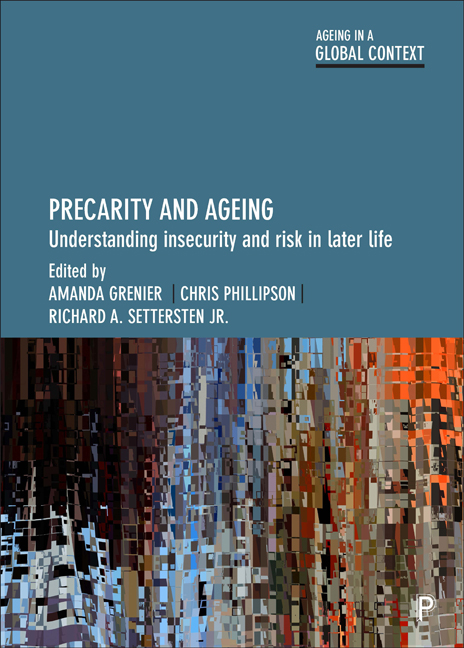Book contents
- Frontmatter
- Contents
- List of Figures and Tables
- Notes on Contributors
- Editors’ Acknowledgements
- Series Editors’ Preface
- 1 Precarity and Ageing: New Perspectives for Social Gerontology
- PART I Life Course Perspectives on Precarity
- PART II Precarity Across Situations
- PART III Austerity, Care and Social Responses to Precarity
- Index
6 - Precarity, Migration and Ageing
Published online by Cambridge University Press: 02 March 2021
- Frontmatter
- Contents
- List of Figures and Tables
- Notes on Contributors
- Editors’ Acknowledgements
- Series Editors’ Preface
- 1 Precarity and Ageing: New Perspectives for Social Gerontology
- PART I Life Course Perspectives on Precarity
- PART II Precarity Across Situations
- PART III Austerity, Care and Social Responses to Precarity
- Index
Summary
Introduction
The profile of older adults in the Global North is rapidly diversifying, with increasing proportions of foreign-born ageing populations in large immigrant-receiving countries like Canada and the United Kingdom. In Canada, for example, 30 per cent of those aged 65 years and over are foreign-born (Ng et al, 2012). Yet, despite this demographic significance of the foreign-born older adult population, very little research has been conducted on the complex and varied experiences of risk and insecurity vis-a-vis ageing and life course events such as international migration. It is, therefore, timely to critically examine the markers of immigration, race and ethnicity, and cultural beliefs and practices, as they intersect with poverty and socioeconomic inequality among immigrant older adults. This is particularly the case given that these intersections are likely to manifest in experiences of invisibility, marginalization and social exclusion.
This chapter presents a nuanced analysis of precarity, risk and vulnerability as it relates to ageing and migration. It begins with a story of migration that sets the context for the chapter. It then provides an outline of precarity in relation to migration, and a brief overview of the key economic and psychosocial/cultural markers of precarity in older immigrants. Next, it highlights the ‘politics of precarity’ that are inherent in the larger political economy of immigration and the relative invisibility of racialized immigrant older adults in health and social care policies, and, drawing on these, returns to a discussion of precarity among older immigrant adults. Examples of media stories about, and interviews with, older immigrants are provided throughout the chapter as a means to ground our analysis in everyday examples. The chapter concludes with a discussion of the challenges to understanding precarity in the context of migration, and provides suggestions for future research.
A story of migration: setting the context
Keith Bi is a forty-seven-year-old Chinese immigrant and the owner of Coffee Corner, a café located in the windowless basement below the office of Citizenship and Immigration Canada. Bi immigrated from the city of Xi’an, China, on a working visa after being told by one of his relatives who lives in Halifax that Canada is a good place to live.
- Type
- Chapter
- Information
- Precarity and AgeingUnderstanding Insecurity and Risk in Later Life, pp. 115 - 146Publisher: Bristol University PressPrint publication year: 2020

